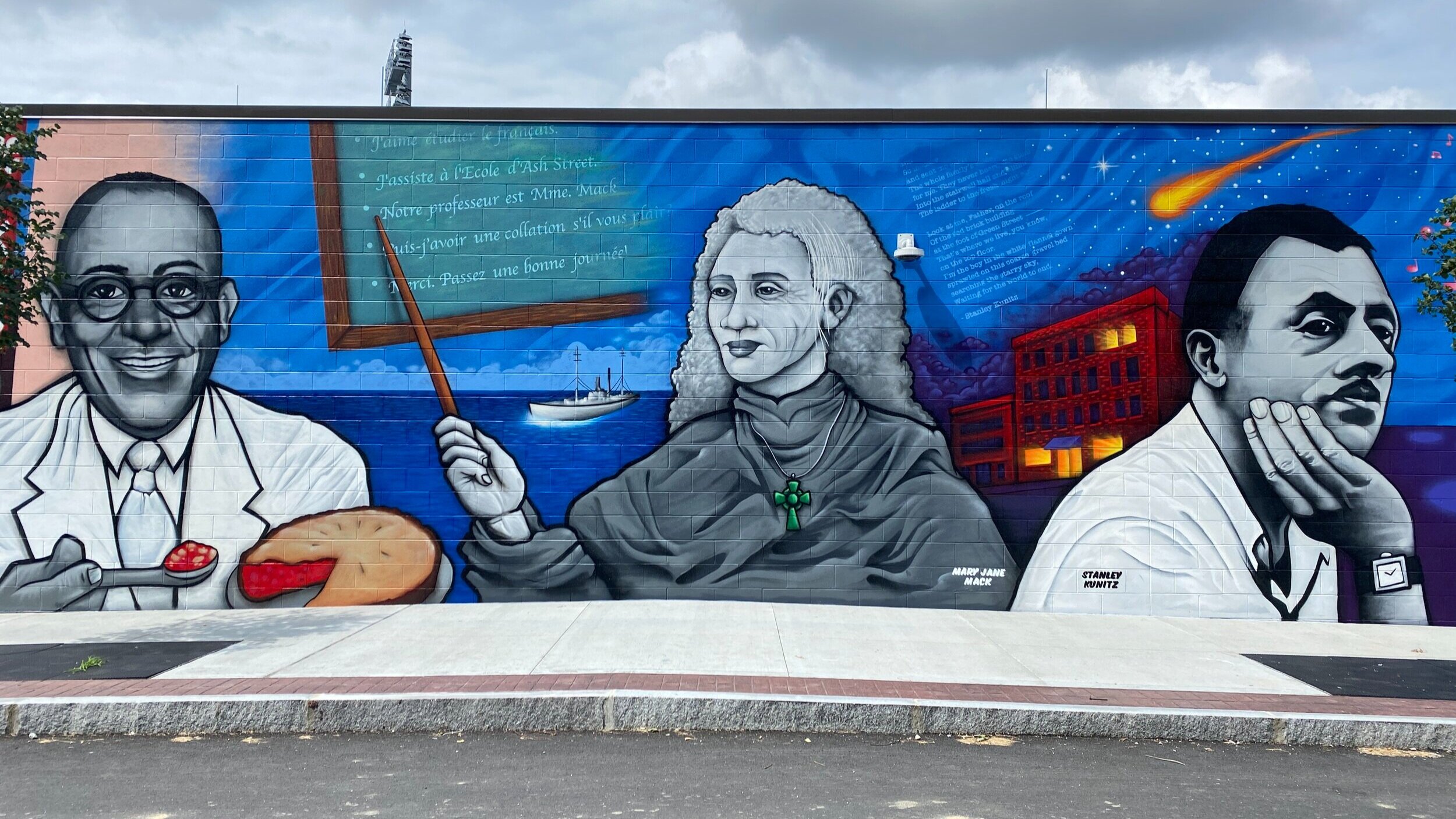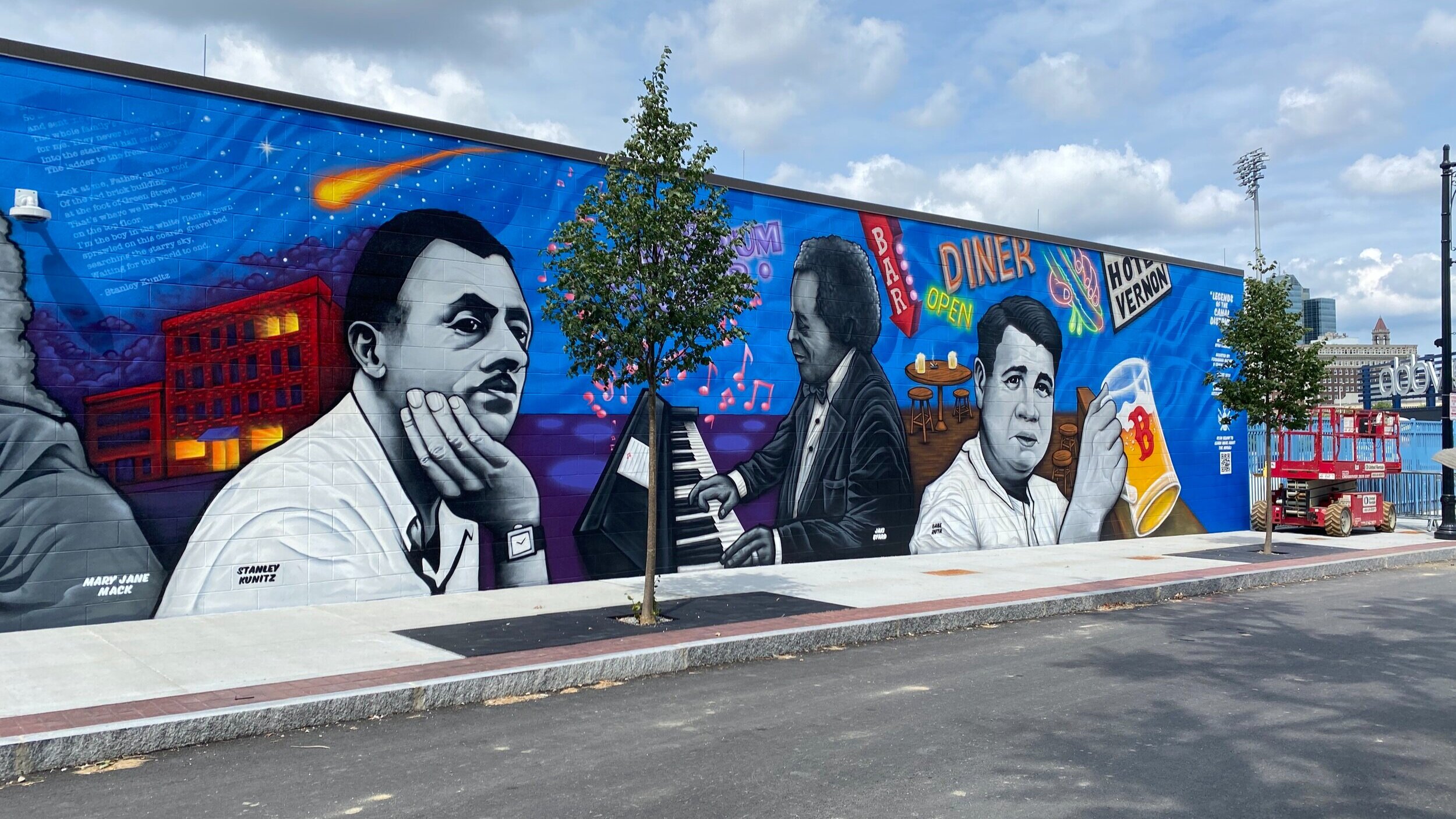‘Legends of the Canal District’ - Polar Park
Project designed & led by Ryan Gardell
Assisted by Ferdinand Nazario & Ghrimm Xavier
Painted at Polar Park in August 2021
Biographical contributions by Allen Fletcher
Special thanks to Janet Marie Smith
#1. “The Athlete” - Babe Ruth
George Herman “Babe” Ruth spent time in Worcester during his tenure with the Boston Red Sox -- visiting his mentor, Sox coach Jack Barry, at his home on View Street and hoisting more than a few tall ones at the Hotel Vernon in Kelley Square.
Born in 1895 in Baltimore, Maryland, he was farmed out at an early age to a local reformatory and orphanage because his saloon-keeper father could not keep him in line. There, he learned the skills of carpentry, shirt-making, and baseball. He began his career with the minor league Baltimore Orioles and was sold to the Boston Red Sox in 1914. He helped the Sox win three world series titles, primarily as a pitcher; and he was infamously sold to the New York Yankees in 1920.
It was primarily during the off-seasons of these years that he frequented the Hotel Vernon. Reportedly it was the hotel’s proprietor, Michael McGady, who convinced him to continue his baseball career after one disheartening season with the Sox.
Ruth’s 22 year, major league baseball career is legendary. He retired in 1935, holding numerous of the sport’s batting records; and he was inducted into the inaugural class of the Hall of Fame in 1937 along with fellow legends Ty Cobb, Honus Wagner, Christy Mathewson and Walter Johnson.
Denied employment in major league baseball because of his intemperate lifestyle, Ruth suffered a difficult retirement, although he remained a wildly popular figure in sporadic public appearances. He died of cancer in 1948, at the age of 53.
#2. “The Musician” - Jaki Byard
John Arthur “Jaki” Byard was an internationally known jazz pianist who formed part of the legendary jazz scene on Summer Street in the pre-World War II era – a street that was leveled by the construction of Route I-290 in the 1960s.
Born in 1922, he lived on Clayton Street and attended Commerce High School. He and local jazz fixtures Howie Jefferson (saxophone) and Barney Price (trumpet) started the famous Saxtrum Club – a late night jam club that famously hosted touring musicians in the region. The likes of Gene Krupa, Anita O’Day, Cozy Cole, Cab Calloway, Charle Ventura, Fats Waller, Joe Venuti, Al Hirt and Frank Sinatra all visited there.
After a stint in the army, Byard played with various bands in the Boston area and moved to New York City in the early 1960s. He was well known as a teacher as well as a musician. He played saxophone as well as piano and was known for his broad repertoire ranging from boogie-woogie to free jazz. He performed and recorded with the likes of Maynard Ferguson, Art Blakey, Herb Pomeroy, Eric Dolphy, Roland Kirk and Charles Mingus, among many others. He filled the piano chair of the Duke Ellington Orchestra when Ellington was ill late in his life. He recorded some 85 albums as both leader and back-up musician.
He was killed in Queens, New York in 1999 as a result of an unsolved attack in his home.
#3. “The Poet” - Stanley Kunitz
Stanley Jasspon Kunitz was twice named poet laureate of the United States – in 1974 and 2000 -- having spent his childhood years in Worcester, some of them in a coldwater flat at the corner of Ash Street and Green Street.
Born to Lithuanian Jewish immigrant parents in 1905, he attended Classical High School, where he was valedictorian, and Harvard College. It was as a young reporter for the Worcester Telegram that he covered the famous Sacco-Vanzetti trial in Boston and became interested in publishing Vanzetti’s letters – which led to his departure to the bright lights of New York City.
Kunitz taught literature and poetry at various colleges throughout his life, as well as producing his impressive body of poetry, some of which referenced his childhood home. He maintained a summer cottage in Provincetown, famous for its beautiful seaside gardens.
In later years, he reconciled to the city of his birth, which he had once rejected for its small-minded provincialism. He died at the age of 101.
#4. “The Educator” - Mary Jane Mack
Mary Jane Mack taught at the Ash Street School, directly across Summit Street from the mural, for 55 years – the majority of those years as principal.
Thought to have been born on a boat from Ireland, she lost her parents at an early age. She attended Classical High School and graduated from the Worcester teaching school at the age of 16, her tuition having been paid by civic leaders. She taught for 63 years, a record for continuous service to the school system, and was known as a strict disciplinarian and a French scholar.
Her death in 1917 at the age of 83 inspired a front page article in the Worcester Telegram citing the long list of prominent City figures who had benefited from her tutelage. The gingko tree across the street from the mural was planted in her memory.
As was the requirement of female teachers in that era, she never married.
#5. “The Entrepreneur” - Theodore Tonna
Theodore Tonna was one of the founders of Table Talk Pies, an industrial stalwart of the Canal District for nearly 100 years.
Born in Macedonia in 1898, he immigrated to Rhode Island in 1914, after his shepherd father had been killed by a rustler. He worked for bakers in Woonsocket, RI, and Worcester, before striking out on his own with fellow Greek Angelo Cotsidas. The two founded Table Talk in 1924, eventually specializing in its iconic 4” pie. For decades, it provided employment to the local labor force – particularly members of the Greek immigrant community.
After being sold to Beechnut in 1965 and later being shut down, Table Talk was purchased out of bankrupcy and reopened by Tonna’s son in law, Christos Cocaine in 1986. Tonna died the following year. Still producing some 250 million pies yearly, the company opened a retail store on Green Street in 2015 and moved to its new facility in Main South in 2022.
#6. “The Activist” - Emma Goldman
Emma Goldman was a renowned political activist and writer who, with her lover Sascha Berkman, operated an ice cream shop in the Canal District in 1892.
Born in current day Lithuania in 1869, she immigrated to Rochester, New York, in 1885, supporting herself as a seamstress and becoming converted to the anarchist cause and affiliated women’s rights and social issues. She quickly became renowned as a charismatic public speaker.
After their adventure in the ice cream business, Goldman and Berkman departed Worcester in a failed attempt to assassinate the president of Standard Oil, Henry Clay Frick. She subsequently was jailed numerous times for “inciting to riot” in support of social causes, for opposing the military draft and for distributing information on birth control. Her writing and speeches treated wide a variety of subjects, including prisons, atheism, freedom of speech, militarism, capitalism, marriage, free love, and homosexuality.
In 1906, she founded the anarchist journal Mother Earth.
Goldman later returned to Russia but became disenchanted with the Bolshevik cause there. She also travelled to Spain in support of the revolution there. She died in Toronto, Canada, at the age of 70, having published her iconic biography Living My Life several years earlier.
#7. “The Laborer” - Tobias Boland
Tobias Boland was the contractor for the construction of the Blackstone Canal, which connected the City of Worcester to the Atlantic Ocean at Providence, RI, opening as a commercial enterprise in 1828.
Born in Tipperary, Ireland, in 1795, he constructed parts of the Erie Canal in New York State, before being lured to Worcester for the Blackstone project. His crew of Irish laborers lived in the current Shrewsbury Street area, having been banned from residence within the town limits. Subsequently, Boland was instrumental in the construction of both the Boston and Worcester Railroad and the Worcester and Western Railroad, which contributed to the Canal’s demise in 1848.
Boland developed both Temple and Winter streets in the Canal District and built houses in the area. He also constructed the first building of what is now the College of the Holy Cross. He died in 1886 in Charlestown, MA.
The Canal was arched over in the 1890s and still flows underneath Harding Street through Kelley Square.


































